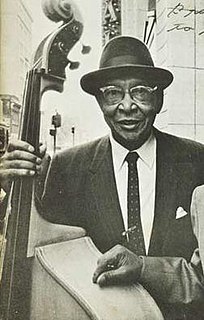Dick Lammi (January 15, 1909 – November 29, 1969) was an American jazz tubist and bassist associated with Dixieland jazz.
Jazz is a music genre that originated in the African-American communities of New Orleans, United States, in the late 19th and early 20th centuries, and developed from roots in blues and ragtime. Jazz is seen by many as "America's classical music". Since the 1920s Jazz Age, jazz has become recognized as a major form of musical expression. It then emerged in the form of independent traditional and popular musical styles, all linked by the common bonds of African-American and European-American musical parentage with a performance orientation. Jazz is characterized by swing and blue notes, call and response vocals, polyrhythms and improvisation. Jazz has roots in West African cultural and musical expression, and in African-American music traditions including blues and ragtime, as well as European military band music. Intellectuals around the world have hailed jazz as "one of America's original art forms".
Lammi played violin and banjo early in his career, and played as a banjoist in various groups in the Pacific Northwest in the late 1920s. He settled in Portland, Oregon in the early 1930s, and played bass in a group there; after a move to San Francisco in 1936, he began playing tuba alongside bass. His best-known work was as a member of Lu Watters's band, the Yerba Buena Jazz Band. Lammi played in the ensemble from 1941 to 1950, including on virtually all of their recordings.

The Pacific Northwest (PNW), sometimes referred to as Cascadia, is a geographic region in western North America bounded by the Pacific Ocean to the west and (loosely) by the Cascade Mountain Range on the east. Though no official boundary exists, the most common conception includes the Canadian province of British Columbia (BC) and the U.S. states of Idaho, Oregon, and Washington. Broader conceptions reach north into Southeast Alaska and Yukon, south into northern California, and east of the Continental Divide to include Western Montana and parts of Wyoming. Narrower conceptions may be limited to the coastal areas west of the Cascade and Coast mountains. The variety of definitions can be attributed to partially overlapping commonalities of the region's history, culture, geography, society, and other factors.

Portland is the largest and most populous city in the U.S. state of Oregon and the seat of Multnomah County. It is a major port in the Willamette Valley region of the Pacific Northwest, at the confluence of the Willamette and Columbia rivers. As of 2017, Portland had an estimated population of 647,805, making it the 26th-largest city in the United States, and the second-most populous in the Pacific Northwest. Approximately 2.4 million people live in the Portland metropolitan statistical area (MSA), making it the 25th most populous MSA in the United States. Its Combined Statistical Area (CSA) ranks 18th-largest with a population of around 3.2 million. Approximately 60% of Oregon's population resides within the Portland metropolitan area.

San Francisco, officially the City and County of San Francisco, is the cultural, commercial, and financial center of Northern California. San Francisco is the 13th-most populous city in the United States, and the fourth-most populous in California, with 884,363 residents as of 2017. It covers an area of about 46.89 square miles (121.4 km2), mostly at the north end of the San Francisco Peninsula in the San Francisco Bay Area, making it the second-most densely populated large US city, and the fifth-most densely populated U.S. county, behind only four of the five New York City boroughs. San Francisco is also part of the fifth-most populous primary statistical area in the United States, the San Jose–San Francisco–Oakland, CA Combined Statistical Area.
In the 1950s, Lammi worked with Bob Scobey, Turk Murphy, Wally Rose, and Clancy Hayes. He recorded little after the early 1960s, and his exact date of death is disputed.
Robert Alexander Scobey Jr. was an American jazz musician. He was born in Tucumcari, New Mexico and died in Montreal, Quebec, Canada.

Melvin Edward Alton "Turk" Murphy was a trombonist and bandleader who played traditional and Dixieland jazz.
Wally Rose was an American jazz and ragtime pianist.






